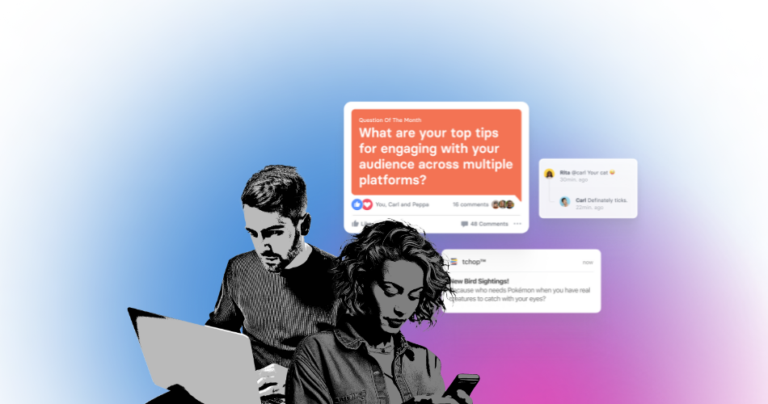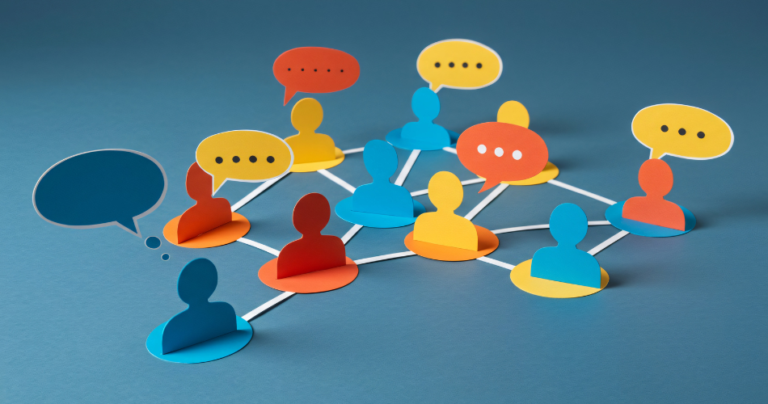Most companies think they have internal communications figured out. You send the newsletter, post the update, maybe throw in a slick video from leadership once a quarter.
Box ticked.
But ask around and you’ll hear the same quiet truth: most of it goes unread, unnoticed or forgotten within a day. People see the message, sure, but that’s not the same as feeling part of something.
The problem?
Internal comms is usually built to inform, not to connect. And connection is what makes the difference between people showing up because they have to… and showing up because they care.
The teams that get this right don’t just “send” information. They create spaces where people talk to each other, not just about work but about the work they’re doing together. Places where updates start conversations, where recognition feels genuine, where ideas can come from anywhere and actually go somewhere.
That’s what a good community does and there’s no reason it should only exist outside your company.
So what happens if we stop treating internal comms like a loudspeaker and start building it like a place people want to gather?

The limits of update-only comms
When internal comms is built around updates, it starts to behave like a noticeboard. Information goes up, people glance at it, maybe it’s relevant for a day or two, then it gets replaced by the next thing.
It’s not that the information is bad. It’s just temporary and it doesn’t stick. It doesn’t build any shared memory or momentum.
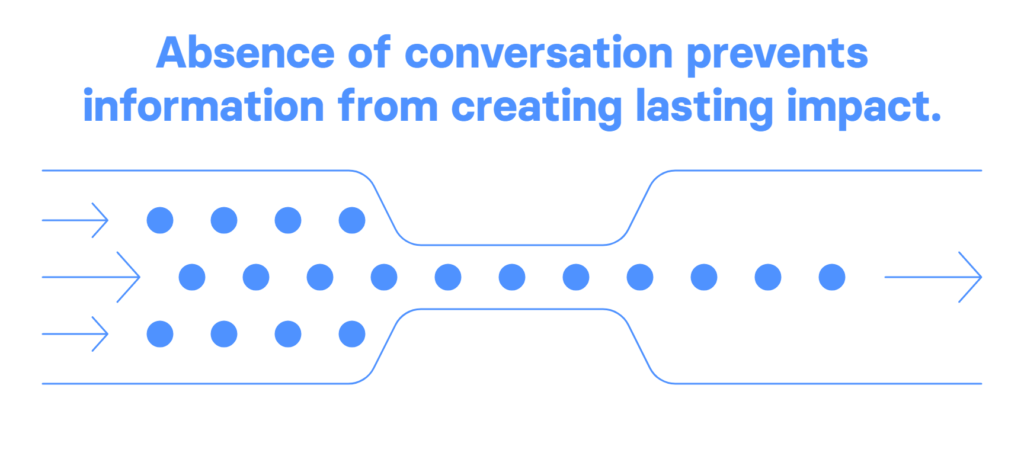
You can send the most well-crafted announcement in the world. Perfectly timed, beautifully designed, even sprinkled with a little humour and it will still fade if there’s no reason for people to talk about it afterwards.
That’s the part most companies miss.
The point of internal comms isn’t just to deliver the news. It’s to create the kind of conversations and connections that keep the news alive.
Because here’s the thing: the content might be yours, but the meaning comes from what happens after it lands. If no one replies, reacts, shares a thought, adds a story of their own; it’s just static.
And static doesn’t build trust. It doesn’t build culture. It doesn’t give people a reason to check back in tomorrow.
So yes, updates matter. But if that’s all you’re doing, you’re not building a real communications ecosystem. You’re just broadcasting into a room you hope people are still standing in.
What it looks like when comms works like a community
When internal comms works like a community, it stops feeling like a one-way channel and starts feeling like a place people go on purpose.
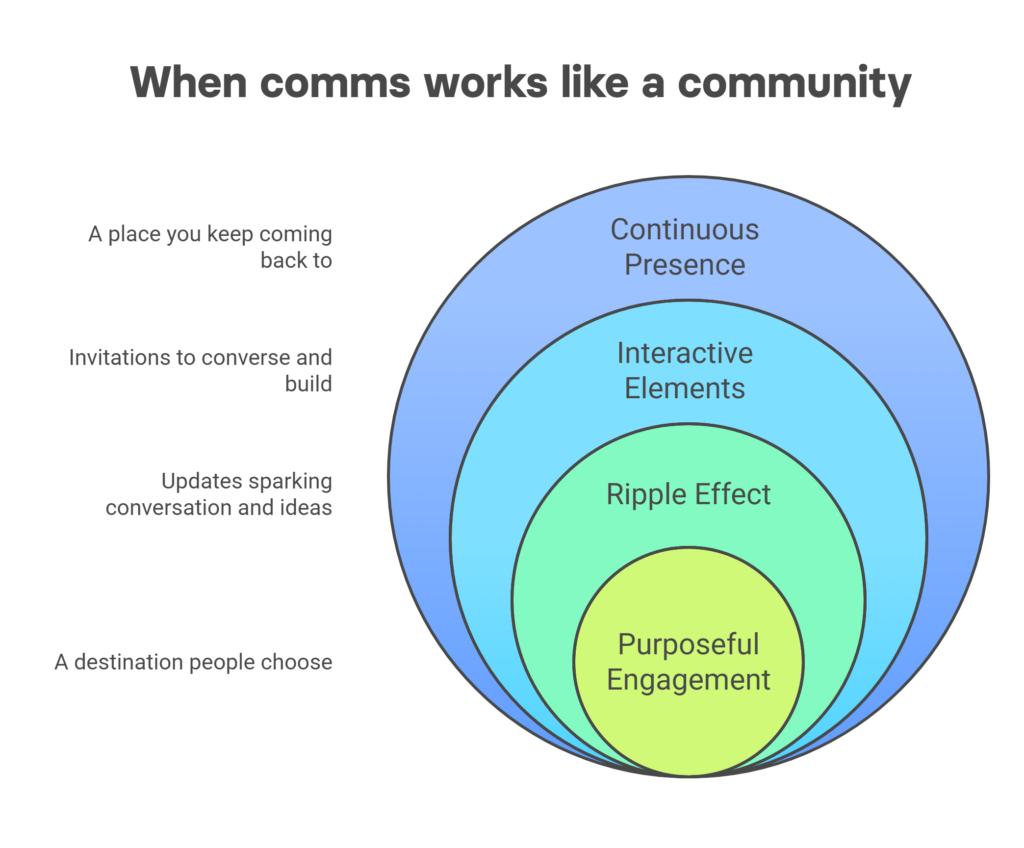
It’s where you hear what’s happening and you get to shape what happens next. It’s where you can celebrate a win, ask a question, throw out an idea or just see what other people across the company are talking about.
The conversation isn’t an afterthought but it’s the whole point. Updates don’t just land and disappear, they spark replies, side chats, spin-off ideas. They create little ripples that keep moving long after the original post. And those ripples turn into shared moments; the inside jokes, the “remember when we…” stories, the feeling that you’re part of something bigger than your own to-do list.
The tools don’t have to be flashy for this to happen. What matters is how they’re used.
- A push notification that invites you into a conversation, not just to click a link.
- An internal event that’s more than a presentation, it’s a space to talk, react and build on what’s being shared.
- A recognition post that’s genuine enough to make people want to add their own shout-outs.
In a real community, comms isn’t a task you check off. It’s a place you keep coming back to because you don’t want to miss what’s happening there or the chance to be part of it.
The activities that actually build connection
If you strip it back, connection is built on two things: being seen and being able to take part.
The companies that nail this don’t just pump out content, they create a rhythm of small, repeatable moments where people can show up, add something and feel it matters.
It’s not about flooding every channel with “more” communication. It’s about creating the right kinds of touchpoints. Ones that pull people in, not push things at them.
Here’s what that can look like in practice:
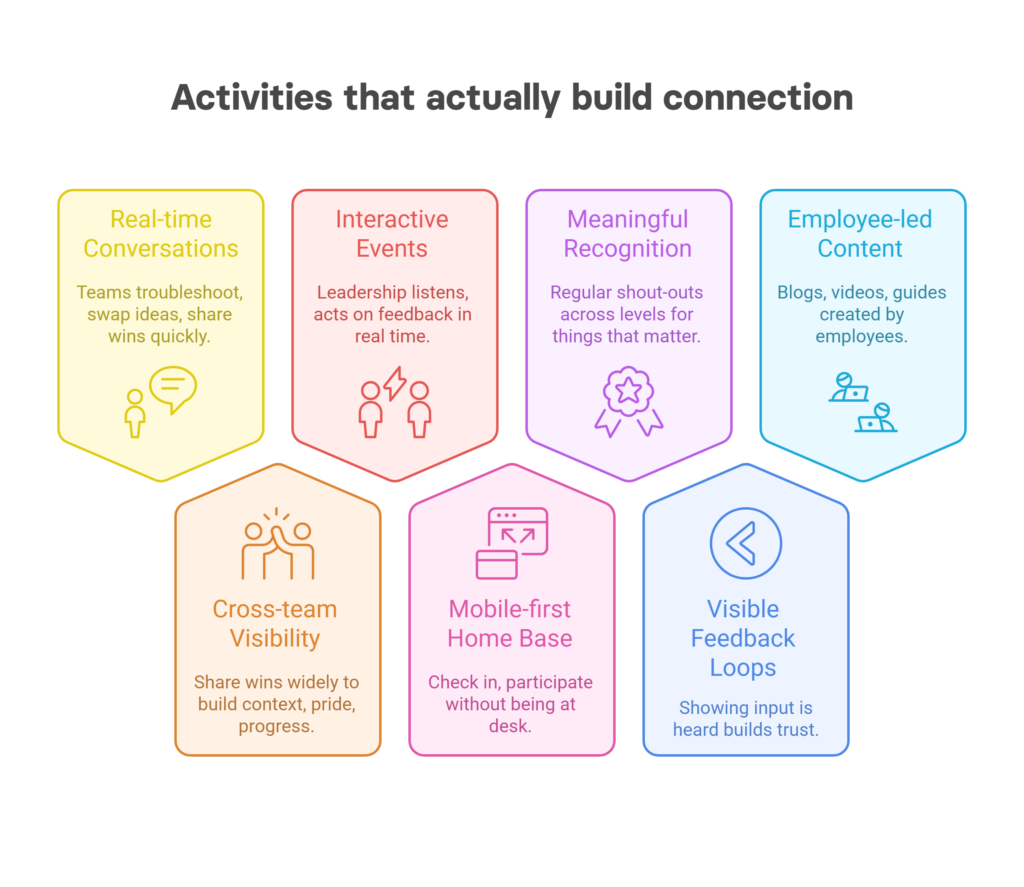
Spaces for real-time conversations
Not another “general chat” that turns into a dumping ground. A space where teams can talk to each other as things happen; to troubleshoot, swap ideas, share the small wins that never make it into a formal update. The magic isn’t in the platform, it’s in how quickly someone can say something and get a response that moves things forward.
Cross-team visibility on wins
When a department lands a deal, finishes a big project or solves a long-standing issue, that story shouldn’t stay locked in their corner of the company. Sharing it widely builds context, pride and a sense of progress that’s contagious. The win becomes something everyone can own, not just the team who made it happen.
Interactive events and town halls
Not the kind where everyone mutes themselves and watches slides for 40 minutes. The ones where leadership talks less and listens more. Where people can ask questions in real time. Where reactions and ideas get captured and acted on after the event, so it doesn’t feel like a one-off performance.
A mobile-first home base
A place where people can check in, see what’s happening and take part, without having to be at their desk. Push notifications that aren’t just pings but invitations. Feeds that aren’t just updates but entry points to a conversation.
Recognition that actually means something
Shout-outs that aren’t just HR exercises. The kind where people recognise each other, across levels and teams, for things that matter. Done regularly enough that it stops feeling like a special occasion and starts feeling like part of how you work.
Feedback loops you can see
Asking for input is easy. Showing you’ve heard it and done something with it, is where trust gets built. When employees can see their suggestions turn into changes, participation stops feeling like a waste of time.
Employee-led content
Not everything has to come from “comms.” Blogs, videos, podcasts, how-to guides. When employees create and share their own content, it brings a voice and perspective no top-down channel can replicate. And it signals that everyone’s voice has weight.
These aren’t “extra” activities you tack onto an existing plan. They’re the plan!
Do them well and suddenly your comms stops being a bulletin board and starts being a place people want to be, because it’s where the real conversations and decisions are happening.

The role of community thinking in internal comms
Community builders already know this truth: people don’t keep showing up for information alone. They show up for connection. And connection is built through a handful of practices that every strong community shares; a common language, repeatable rituals and genuine recognition.
Inside companies, those same practices often get overlooked. Comms turns into announcements and policy updates instead of habits that actually pull people in. But translate community principles into the workplace and suddenly you’ve got something different: communication that people want to be part of.
Shared language that signals belonging
The words people use with each other matter more than leaders realise. In communities, it’s the nicknames, the shorthand, the inside jokes. Inside a company, it might be the way a phrase signals progress or pride. Shared language makes communication recognisable. Without it, updates sound like they could come from anywhere. With it, they feel like they come from here.
Rituals that create rhythm
Communities run on patterns. Weekly check-ins, recurring themes, the little things that make people feel anchored. Companies can do the same. A Monday kickoff thread where everyone shares priorities. A Friday post where wins get collected. A monthly AMA with leadership that employees actually look forward to. These rituals don’t have to be polished or perfect. What matters is the repetition. Over time, they stop being “initiatives” and simply become part of how the place moves.
Recognition that actually counts
Communities thrive when people feel seen. Not with awards once a year, but with regular, genuine acknowledgment. In internal comms, recognition works best when it’s peer-to-peer and woven into daily rhythms: someone calling out a teammate in a thread, a leader responding in the comments, a moment of visibility that tells people their contributions matter. Recognition done this way is a habit. And it builds trust faster than any campaign.
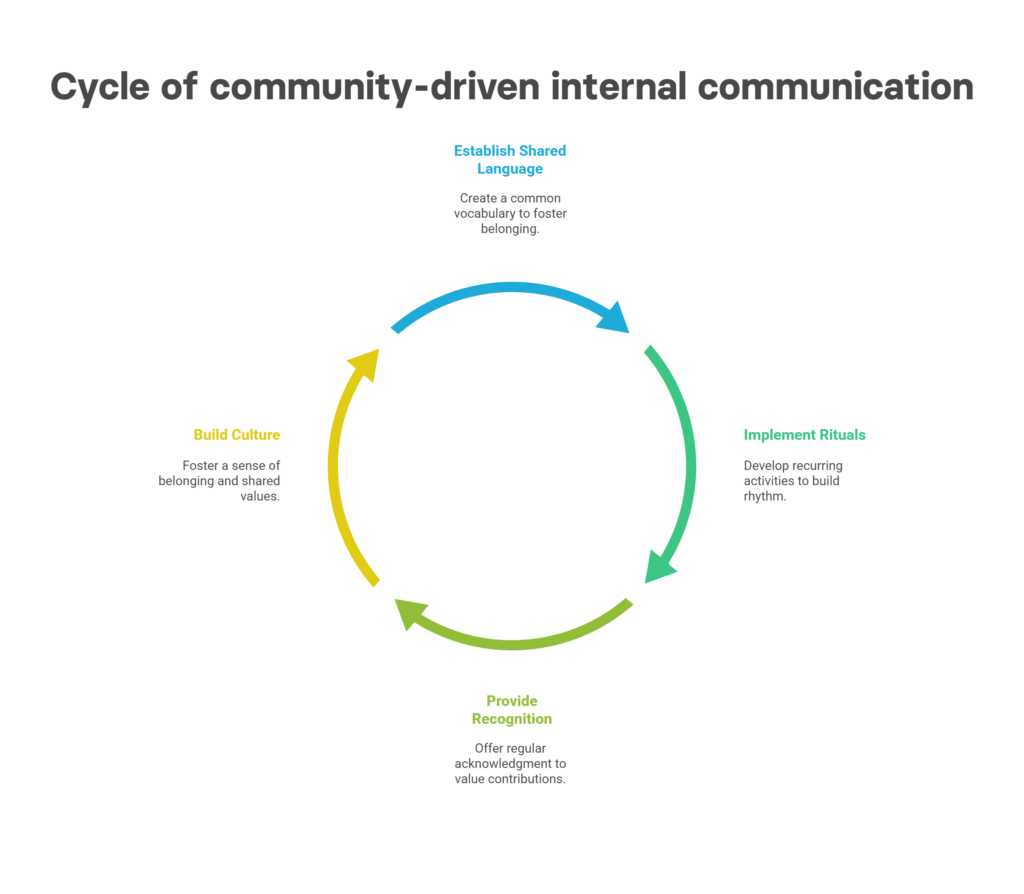
Why it works
Bring language, ritual and recognition into internal comms and the tone changes. Updates don’t feel like interruptions. They feel like part of a living rhythm. Over time, that rhythm builds memory, culture and belonging; the very things most companies say they want but rarely design for. That’s what community thinking looks like on the inside.

How to start evolving your comms into an ecosystem
It’s one thing to see the gap. It’s another to know where to begin.
The word “ecosystem” can feel abstract, like something only massive companies with endless budgets can pull off. But at its core, building an ecosystem just means recognising that communication isn’t a single stream, it’s a set of moving parts that feed each other.
You don’t need to flip the whole system overnight. What you need is to start weaving threads between the things you’re already doing until they stop behaving like silos and start behaving like parts of a whole.
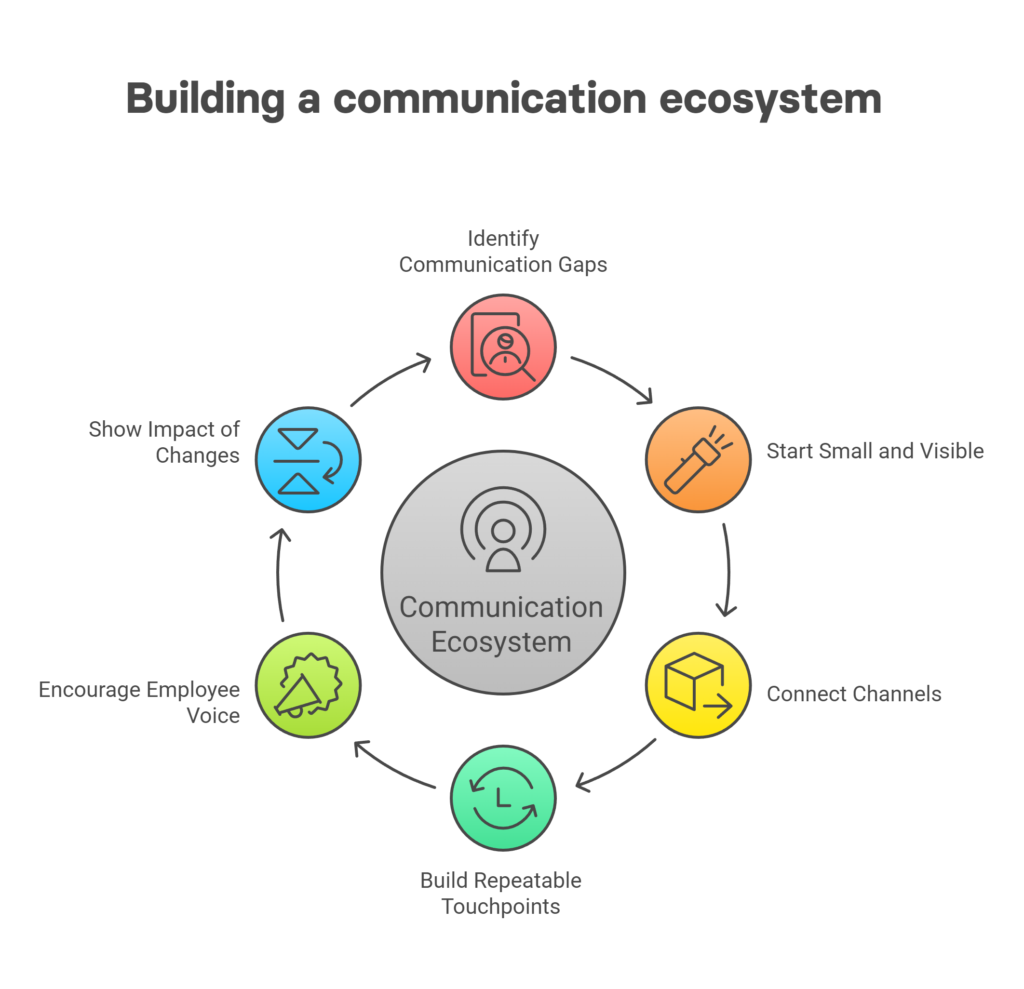
Start small, but make it visible
Pick one place where messages usually disappear into the void. Maybe the monthly update email, maybe the all-hands meeting and add a visible loop. A space where people can comment, react or add their own context. Don’t overthink it. What matters is that people see the shift: “This isn’t just a broadcast anymore, this is a conversation.”
Connect your channels instead of multiplying them
Most employees already juggle too many platforms. The answer isn’t “one more app.” It’s making the existing ones feel connected. If you’re posting news on your intranet, how does it show up in your chat tool? If there’s a leadership video, where does the discussion happen afterwards? The ecosystem view isn’t about adding more. It’s about making sure nothing lives and dies in one place.
Build repeatable touchpoints
A one-off event won’t change the culture. What shifts behaviour are the things people can rely on: the weekly check-in thread, the Friday round-up, the quarterly ask-me-anything. Repeatability creates rhythm and rhythm creates expectation. Over time, these small anchors make the ecosystem feel alive without you having to constantly reinvent it.
Make space for employee voice
An ecosystem isn’t something leaders “run.” It’s something everyone contributes to. Start small: invite employees to share their own updates, stories or lessons learned. Give them the same visibility as leadership posts. When people see that their voice travels as far as anyone else’s, the ecosystem stops being “their comms” and starts being “our place.”
Show what changes because of it
The quickest way to kill trust is to ask for feedback and do nothing with it. The quickest way to build momentum is to show, even in small ways, that contributions make a difference. Close the loop: “We heard this in last week’s thread, here’s what we’ve done.” These micro-moments teach people that the ecosystem isn’t just a stage. It’s a place where things move.
Internal comms as infrastructure for belonging
At the end of the day, this isn’t really about tools or channels. It’s about whether people feel like they belong in the place they work.
Belonging doesn’t come from a slick newsletter or another “mandatory fun” initiative. It comes from being part of a system where your voice carries, where your presence matters, where you can see yourself in the rhythm of the company.
That’s why thinking of internal comms as infrastructure is so important. Not as a megaphone, not as a department but as the wiring that holds connection together. Infrastructure doesn’t show off. It makes things work. It shapes how information moves, how trust builds, how culture gets reinforced; not through one big campaign but through a thousand small signals repeated every day.
And when you get that infrastructure right, something bigger happens. Updates stop being chores, conversations stop being forced, recognition stops being performative. The system itself starts creating belonging, because it’s designed to include people instead of just inform them.
That’s the test worth aiming for: not “did they read it?” but “did they feel part of it?”
Because in the end, culture isn’t what you announce. It’s what people experience together. And the way you build internal comms will decide whether that experience feels flat… or like community.






